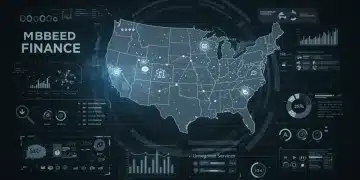US Fintech and Financial Inclusion: Expanding Access to Financial Services

US Fintech and Financial Inclusion leverages technology to democratize financial services, offering innovative solutions that broaden access and reduce traditional barriers for underserved populations in the United States.
The landscape of finance is rapidly evolving, and at the forefront of this transformation in the US is the rise of US Fintech and Financial Inclusion. Technology is becoming an increasingly powerful tool, breaking down barriers to financial services and offering opportunities to previously underserved populations.
Understanding Fintech and Financial Inclusion in the US
Fintech, short for financial technology, encompasses innovative technological applications in the financial sector. In the US, it plays a pivotal role in promoting financial inclusion, aiming to extend access to affordable, convenient, and secure financial services to individuals and communities who have traditionally been excluded from the mainstream financial system.
Financial inclusion is crucial for economic empowerment, enabling individuals to participate fully in the economy, build assets, and improve their financial well-being. By leveraging technology, fintech companies are developing solutions that address many of the challenges that have historically hindered financial inclusion.

The Role of Mobile Banking and Digital Wallets
Mobile banking and digital wallets have emerged as vital instruments in expanding financial inclusion. They offer convenient and accessible alternatives to traditional banking services. These services are particularly beneficial for individuals who may lack access to physical bank branches or have limited mobility.
Digital wallets enable users to store funds, make payments, and receive money directly from their mobile devices, bypassing the need for a traditional bank account. This ease of use and accessibility make them attractive options for individuals with lower financial literacy or limited technological skills.
- Enhanced accessibility: Mobile banking applications and digital wallets are accessible from anywhere with an internet connection, bringing financial services to remote or underserved communities.
- Reduced costs: Fintech solutions often have lower overhead costs compared to traditional banks, allowing them to offer services at a lower cost to consumers.
- Convenience: Fintech platforms offer 24/7 access to financial services, enabling users to manage their finances on their own schedule.
- Increased security: Advanced security measures, such as biometric authentication and encryption, enhance the safety and security of digital financial transactions.
In conclusion, fintech is vital in expanding financial inclusion in the US by providing innovative and accessible solutions to traditionally underserved communities, addressing barriers and empowering individuals to participate more fully in the economy.
The Impact of Fintech on Underserved Communities
Fintech is making significant strides in reaching underserved communities in the US, who often face systemic barriers to accessing traditional financial services. These barriers may include a lack of credit history, low income, and limited access to transportation.
By leveraging data and technology, fintech companies can assess creditworthiness and offer financial products and services tailored to the unique needs of these communities. This approach helps to bridge the gap between traditional financial institutions and individuals who have been historically excluded.
Serving the Unbanked and Underbanked
A significant portion of the US population is either unbanked (having no bank account) or underbanked (having a bank account but relying on alternative financial services like payday loans). Fintech companies are developing innovative solutions to cater to this segment of the population.
These solutions include prepaid debit cards, mobile banking platforms, and micro-lending services. By offering these services, fintech companies provide a convenient and affordable way for unbanked and underbanked individuals to manage their finances, build credit, and access essential financial services.
- Credit building: Fintech platforms offer opportunities for individuals with limited or no credit history to build credit through responsible use of their products, such as secured credit cards and credit-builder loans.
- Affordable lending: Fintech lenders provide access to small-dollar loans with transparent terms and reasonable interest rates, helping individuals avoid predatory lending practices.
- Financial literacy: Fintech companies offer educational resources and financial planning tools to help individuals improve their financial literacy and make informed decisions.
In conclusion, through tailored solutions and alternative services, fintech is playing a crucial role in serving the unbanked and underbanked, providing them with tools to manage finances, build credit, and enhance their financial well-being, thus fostering greater financial inclusion.
Addressing the Digital Divide
While fintech offers great potential for financial inclusion, it is essential to acknowledge and address the digital divide. The digital divide refers to the gap between those who have access to technology and the internet and those who do not. This divide can create additional barriers for individuals who are already marginalized.
To ensure that fintech solutions are truly inclusive, efforts must be made to bridge the digital divide by improving access to affordable internet, providing digital literacy training, and developing user-friendly interfaces that can be easily navigated by individuals with varying levels of technological proficiency.
Improving Digital Literacy and Access
Digital literacy is crucial for individuals to effectively utilize fintech platforms and manage their finances online. Many organizations and fintech companies are offering digital literacy programs to help individuals develop the skills they need to navigate the digital financial landscape.
Additionally, initiatives are underway to expand access to affordable internet services, particularly in low-income and rural communities. By addressing these challenges, the digital divide can be narrowed, allowing more individuals to benefit from the advantages of fintech.

- Community partnerships: Collaborating with local organizations, schools, and community centers to offer digital literacy training programs and workshops.
- Mobile-first design: Developing fintech platforms with mobile-first design principles to ensure accessibility for users with limited access to desktop computers.
- Accessibility features: Incorporating accessibility features, such as text-to-speech and screen readers, to accommodate users with disabilities.
In summary, improving digital literacy and access is paramount to bridging the digital divide and ensuring that the benefits of fintech are available to all, empowering individuals and communities to participate fully in the digital economy.
The Future of Fintech and Financial Inclusion in the US
Looking ahead, the future of fintech and financial inclusion in the US is promising. As technology continues to evolve, new opportunities will emerge to further expand access to financial services, reduce costs, and improve the user experience. Innovations such as artificial intelligence (AI), blockchain technology, and decentralized finance (DeFi) have the potential to disrupt the traditional financial system and create new pathways for financial inclusion.
Moreover, partnerships between fintech companies, traditional financial institutions, and government agencies will be crucial in driving progress and ensuring that fintech solutions are aligned with the needs and priorities of underserved communities.
Emerging Technologies and Their Potential
Emerging technologies like AI, blockchain, and DeFi are poised to revolutionize the financial sector. AI can enhance credit scoring models, personalize financial advice, and automate customer service. Blockchain technology can improve the security and transparency of financial transactions, reducing the risk of fraud and increasing trust. DeFi offers new opportunities for decentralized lending, borrowing, and investing, potentially democratizing access to capital and wealth-building opportunities.
However, it is essential to carefully consider the potential risks and challenges associated with these technologies. Regulatory frameworks must be developed to protect consumers, prevent illicit activities, and ensure that these technologies are used responsibly.
- AI-powered financial advice: Personalized financial advice powered by artificial intelligence can help individuals make informed decisions about saving, investing, and managing debt.
- Blockchain for secure payments: Blockchain technology can be used to create secure and transparent payment systems that reduce transaction costs and improve efficiency.
- DeFi for inclusive investing: Decentralized finance platforms can provide access to investment opportunities for individuals with limited capital, promoting financial inclusion and wealth creation.
In conclusion, emerging technologies hold immense potential for fintech and financial inclusion in the US, transforming traditional systems and creating new avenues for accessible financial services, provided they are implemented responsibly and guided by thoughtful regulatory frameworks.
Regulatory Considerations and Consumer Protection
As the fintech industry continues to grow and evolve, it is essential to have appropriate regulatory frameworks in place to protect consumers and ensure the stability of the financial system. Regulators play a crucial role in setting standards, overseeing compliance, and enforcing rules that promote fair and transparent practices.
Consumer protection is paramount, particularly when dealing with vulnerable populations who may be more susceptible to fraud and predatory lending practices. Regulations should address issues such as data privacy, cybersecurity, and fair lending to safeguard consumers’ interests.
Balancing Innovation and Consumer Safety
Finding the right balance between fostering innovation and promoting consumer safety is a key challenge for regulators. Overly restrictive regulations can stifle innovation and limit the development of new fintech solutions. On the other hand, inadequate regulations can expose consumers to unnecessary risks and undermine trust in the financial system.
A collaborative approach involving regulators, fintech companies, and consumer advocacy groups is essential to develop effective and balanced regulatory frameworks. This approach ensures that regulations are responsive to the evolving needs of the industry while protecting the interests of consumers.
- Regulatory sandboxes: Creating regulatory sandboxes that allow fintech companies to test new products and services in a controlled environment, enabling regulators to assess potential risks and benefits before widespread adoption.
- Data privacy regulations: Implementing data privacy regulations that protect consumers’ personal and financial information, ensuring that data is used responsibly and ethically.
- Anti-predatory lending laws: Enacting anti-predatory lending laws to protect consumers from abusive lending practices, such as high-interest rates, hidden fees, and unfair terms.
In summary, balanced regulatory frameworks are critical to protect consumers and maintain financial stability, while also fostering innovation in the fintech industry; a collaborative approach is essential to ensuring regulations are effective, responsive, and fair for all stakeholders.
Case Studies: Successful Fintech Initiatives for Financial Inclusion
Examining successful case studies of fintech initiatives that have made a significant impact on financial inclusion provides valuable insights and lessons learned. These case studies demonstrate the potential of fintech to address specific challenges and improve financial outcomes for underserved communities.
By analyzing the strategies, approaches, and outcomes of these initiatives, stakeholders can identify best practices, replicate successful models, and develop new solutions tailored to their specific contexts.
Examples of Impactful Fintech Solutions
One example is a fintech company that partners with local non-profits to offer affordable microloans to small business owners in low-income communities. These loans provide access to capital, enabling entrepreneurs to start or expand their businesses, create jobs, and stimulate economic growth.
Another case study involves a mobile banking platform that offers free checking accounts and financial literacy resources to unbanked individuals. This platform helps individuals manage their finances, build credit, and access essential banking services without incurring high fees.
- Chime: A mobile banking app that offers fee-free checking and savings accounts, helping individuals avoid overdraft fees and build savings habits.
- Kiva: A peer-to-peer lending platform that connects borrowers in developing countries with lenders, providing access to capital for small businesses and entrepreneurs.
- Earnin: An app that allows workers to access their earned wages before payday, helping them avoid late fees and payday loans.
In conclusion, examining successful fintech initiatives for financial inclusion provides valuable insights and inspiration for future endeavors, serving as models for effective strategies, innovative approaches, and impactful solutions in the quest to improve financial outcomes for underserved communities. These initiatives demonstrate the power of fintech to transform lives and create more inclusive economies.
| Key Point | Brief Description |
|---|---|
| 🌐 Digital Divide | Addressing gaps in technology access is crucial for inclusive fintech. |
| 📱 Mobile Banking | Mobile solutions expand financial access to underserved communities. |
| 🛡️ Regulation | Balanced regulations protect consumers while fostering fintech innovation. |
| 🤖 Emerging Tech | AI and blockchain offer new pathways for financial inclusion. |
Frequently Asked Questions
▼
Fintech uses technology to provide affordable and accessible financial services to underserved populations, breaking down traditional barriers.
▼
Mobile banking offers convenient access to financial services through smartphones, benefiting those lacking traditional bank branches.
▼
Bridging the digital divide ensures equal access to fintech benefits, providing digital literacy and affordable internet.
▼
AI can personalize advice, blockchain secures transactions, and DeFi democratizes finance, expanding inclusion and opportunity.
▼
Effective regulation balances innovation and consumer protection, promoting industry growth and ensuring consumer trust in fintech services.
Conclusion
In conclusion, US Fintech and Financial Inclusion is reshaping the financial landscape, democratizing access to financial services and empowering underserved communities. By leveraging technology and innovative approaches, fintech companies are driving progress toward a more inclusive and equitable financial system for all Americans.





